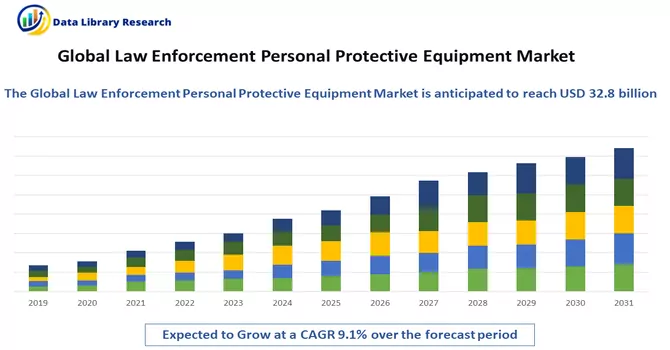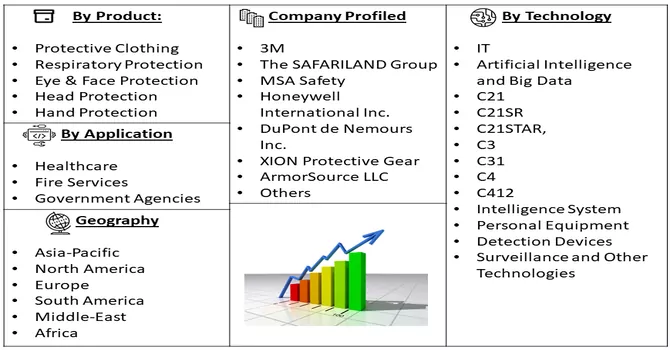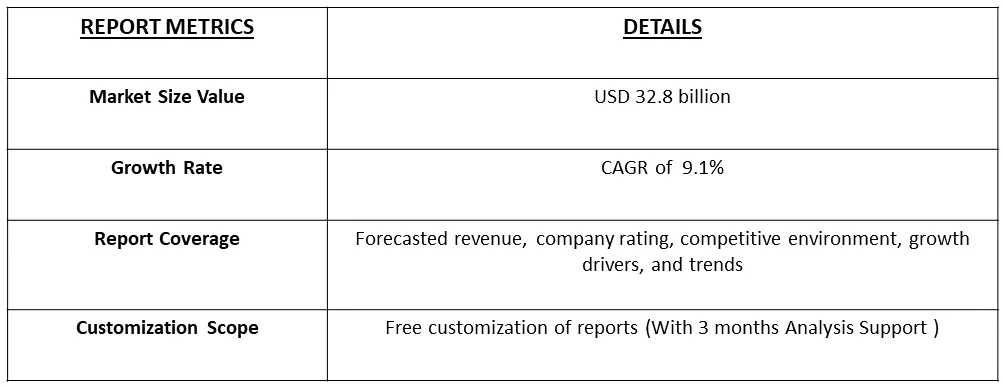The global law enforcement personal protective equipment market size grew from USD 32.8 billion in 2023 and registered a CAGR of 9.1% over the forecast period, 2024-2031.

Get Complete Analysis Of The Report - Download Free Sample PDF
Global Law Enforcement Personal Protective Equipment (PPE) refers to specialized gear and equipment designed to safeguard law enforcement personnel from various occupational hazards they may encounter during the execution of their duties. This equipment is crucial in providing protection against physical, chemical, biological, and ballistic threats. Law enforcement PPE includes a diverse range of items such as bulletproof vests, helmets, riot gear, gloves, gas masks, body armor, and other specialized gear tailored to specific operational needs. The primary goal of law enforcement PPE is to enhance the safety and well-being of police officers and other law enforcement personnel while ensuring their ability to effectively carry out their duties. This equipment is designed to mitigate the risks associated with different scenarios, including crowd control, riot situations, firearms encounters, and exposure to hazardous materials. Law enforcement agencies worldwide adhere to standards and regulations governing the use and specifications of PPE to ensure consistency and effectiveness. The continuous advancement of materials and technologies contributes to the development of increasingly sophisticated and protective gear for law enforcement, reflecting a commitment to enhancing officer safety in a variety of operational environments.
The growth of the Law Enforcement Personal Protective Equipment (PPE) market is propelled by a combination of factors addressing the evolving landscape of law enforcement challenges. Increasingly complex threats, technological advancements, and a heightened focus on officer safety drive the demand for advanced PPE solutions. Compliance with stringent regulatory standards, pandemic preparedness, and the need for specialized gear in crowd management scenarios further contribute to market expansion. The global pandemic has underscored the significance of PPE, emphasizing the importance of protective gear in mitigating risks, while international security concerns and a focus on non-lethal technologies contribute to the demand for standardized and interoperable equipment. Budget allocations, public awareness, and advocacy for officer well-being also play pivotal roles, collectively shaping the growth trajectory of the Law Enforcement PPE market, reflecting a commitment to providing law enforcement personnel with the most effective and comprehensive protective gear available.
The Law Enforcement Personal Protective Equipment (PPE) market is witnessing dynamic trends, including the integration of advanced technologies like smart textiles and communication systems, emphasizing lightweight and flexible designs for enhanced mobility, and a growing focus on ballistic and chemical hazard protection. Customization and modularity are on the rise, catering to diverse operational scenarios, while sustainability initiatives reflect a commitment to eco-friendly solutions. Global standardization, interoperability, and a heightened emphasis on respiratory protection, augmented reality, and communication systems demonstrate the industry's response to evolving challenges. Moreover, the pandemic has accelerated the development of PPE tailored for infectious disease control, and the demand for transparency features, such as body-worn cameras, aligns with growing public accountability expectations in law enforcement activities. These multifaceted trends collectively shape an innovative and adaptive landscape in the Law Enforcement PPE market.
Market Segmentation: The Law Enforcement Personal Protective Equipment Market is Segmented By Product (Protective Clothing, Respiratory Protection, Eye & Face Protection, Head Protection, Hand ), and Geography (North America, Europe, Asia-Pacific, South America, and Middle-East and Africa). The market size and forecasts are provided in terms of value (USD million) for all the above segments.

For Detailed Market Segmentation - Download Free Sample PDF
Market Drivers:
The Rise in Global Security Threats, Including Terrorism, Organized Crime, and Civil Unrest
The escalating global security threats, encompassing terrorism, organized crime, and civil unrest, have catalyzed a fundamental reassessment of law enforcement strategies, emphasizing the critical role of personal protective equipment (PPE) in safeguarding the lives and well-being of law enforcement officers. In the face of increasingly complex and diverse threats, ranging from large-scale terrorist incidents to organized criminal activities and civil disturbances, law enforcement agencies worldwide are compelled to enhance their protective measures. The imperative to respond effectively to these challenges has fueled the demand for advanced and specialized PPE that can provide a robust defense against various forms of violence, ballistic threats, and hazardous environments. Law enforcement PPE, ranging from ballistic vests and helmets to riot gear and respiratory protection, has become indispensable in mitigating the risks associated with security threats. The design and functionality of these protective solutions are continually evolving to address the dynamic nature of contemporary threats. Technological advancements, such as the integration of smart textiles, communication systems, and innovative materials, play a pivotal role in enhancing the protective capabilities of this gear. The aim is not only to shield officers from physical harm but also to provide them with tools that enhance situational awareness, communication, and overall operational effectiveness. The rise in global security threats underscores the need for law enforcement agencies to invest in comprehensive and adaptable PPE solutions. These solutions not only offer physical protection but also contribute to the psychological well-being of officers, empowering them to confront and manage evolving threats with confidence. The COVID-19 pandemic further emphasized the importance of respiratory protection within law enforcement PPE, highlighting the need for gear that addresses health-related risks in addition to traditional security threats. Thus, the complex landscape of global security challenges, law enforcement agencies must prioritize the procurement and utilization of PPE that aligns with the specific nature of the threats they face. This involves a strategic balance between ballistic protection, mobility, communication capabilities, and adaptability to diverse operational scenarios. The ongoing commitment to innovation in law enforcement PPE reflects a proactive approach to addressing the ever-changing nature of security threats, ensuring that officers are equipped with the best available tools to confront the challenges of the modern world.
Growing Global Health Concerns
The emergence of growing global health concerns, epitomized by events such as the COVID-19 pandemic, has reshaped the landscape of law enforcement personal protective equipment (PPE). Beyond traditional security threats, law enforcement agencies are now confronted with the imperative to address health-related risks faced by officers during the course of their duties. The pandemic has accentuated the importance of respiratory protection, hygiene measures, and specialized gear designed to mitigate the spread of infectious diseases. In response to these evolving health concerns, law enforcement PPE has witnessed a paradigm shift, with an increased focus on equipment that goes beyond ballistic protection. Respiratory masks, face shields, and other protective gear have become integral components of law enforcement officers' equipment, reflecting the dual challenge of ensuring both physical and health-related safety. The ability of law enforcement agencies to adapt and incorporate measures that protect officers from infectious agents has become paramount in maintaining operational continuity and public safety. The demand for PPE that addresses global health concerns has spurred innovations in materials, design, and technology. Breathable yet protective fabrics, antimicrobial coatings, and advanced filtration systems are among the features integrated into modern law enforcement gear to provide effective defense against biological threats. Additionally, the need for seamless communication, even while wearing protective equipment, has led to advancements in integrated communication systems within PPE. Law enforcement agencies are now required to navigate the complexities of dual-threat scenarios, where traditional security concerns intersect with health risks. The strategic deployment of PPE that caters to both dimensions is essential, ensuring that officers are adequately protected in a range of situations, from routine patrols to emergency response during health crises. This dual-purpose PPE not only enhances the resilience of law enforcement officers but also contributes to broader public health efforts by preventing the potential spread of diseases. As global health concerns continue to evolve, law enforcement agencies are challenged to stay ahead of emerging threats and invest in PPE solutions that provide comprehensive protection. The integration of health-centric features into law enforcement gear exemplifies a proactive approach, acknowledging the interconnected nature of security and public health. In this context, law enforcement PPE becomes a vital component in the broader spectrum of efforts to ensure the safety and well-being of both officers and the communities they serve.
Market Restraints:
Complex Procurement Processes
Law enforcement entities frequently encounter intricate procurement procedures marked by bureaucratic impediments and protracted approval timelines. These intricacies pose a considerable challenge, hindering the swift integration of novel and advanced personal protective equipment (PPE) into the law enforcement sector. The cumbersome nature of these processes can result in delays and obstacles, creating a bottleneck in the timely acquisition and deployment of innovative protective gear. Such bureaucratic hurdles may stem from stringent regulations, extensive vetting procedures, and the need for multiple layers of approvals, collectively contributing to a slower pace of adoption for cutting-edge PPE technologies within law enforcement agencies. This administrative complexity underscores the importance of streamlining procurement frameworks and fostering agility in decision-making to ensure that law enforcement personnel have prompt access to the latest and most effective protective equipment.
The COVID-19 pandemic has exerted a profound impact on the integration of protective clothing and personal protective equipment (PPE) into the law enforcement sector. Beyond the traditional focus on ballistic protection and riot gear, there has been an increased emphasis on respiratory protection, with law enforcement agencies deploying specialized masks and respirators to safeguard officers from airborne particles and infectious agents. The pandemic has accelerated the adoption of advanced technologies and materials in PPE, ensuring that law enforcement personnel have the necessary tools to operate safely in environments with heightened health risks. The integration of communication systems within protective gear has become even more crucial, facilitating seamless coordination and information exchange among officers while adhering to social distancing measures. The pandemic has prompted a reevaluation of safety protocols, driving innovation in protective clothing to address both conventional security threats and health-related risks, reinforcing the adaptability and resilience of law enforcement in the face of unprecedented challenges.
Segmental Analysis:
Protective Clothing Segment is Expected to Witness Significant Growth Over the Forecast Period
The incorporation of protective clothing and personal protective equipment (PPE) into the law enforcement sector is integral to ensuring the safety and effectiveness of officers in diverse operational contexts. This encompasses ballistic protection, including advanced vests and helmets, addressing the persistent threat of firearms. Riot gear, comprising shields and face protection, proves crucial in situations of civil unrest, providing defense against projectiles and physical aggression. Additionally, specialized clothing designed for chemical and biological protection safeguards officers from hazardous materials. Respiratory protection, featuring masks and advanced filtration, has become imperative in the face of global health concerns. Furthermore, the integration of communication systems within protective clothing enhances officers' connectivity and situational awareness during operations. The ongoing evolution of these technologies reflects a commitment to equipping law enforcement personnel with cutting-edge gear, emphasizing both safety and operational efficiency in dynamic and challenging environments.
North America Region is Expected to Witness Significant Growth Over the Forecast Period
In the North America region, the integration of protective clothing and personal protective equipment (PPE) into the law enforcement sector is a cornerstone of ensuring the safety and preparedness of officers across various jurisdictions. This includes the widespread adoption of advanced ballistic protection, such as bullet-resistant vests and helmets, aimed at mitigating the risks associated with firearms and ballistic threats. In response to civil unrest scenarios, North American law enforcement agencies deploy specialized riot gear, encompassing helmets, face shields, and body shields, providing officers with essential protection in dynamic and potentially hazardous situations. The region places a significant emphasis on addressing chemical and biological hazards, reflected in the utilization of protective suits, masks, and gloves to safeguard officers from exposure to hazardous materials. The integration of respiratory protection, especially in the context of global health concerns, is pivotal, with the deployment of respirators and masks equipped with advanced filtration systems to ensure officers can operate safely in environments with airborne contaminants. Moreover, North American law enforcement agencies prioritize the integration of communication systems into protective clothing, fostering enhanced connectivity and coordination among officers during operations. This commitment to technological innovation and safety standards underscores the region's proactive approach to addressing the evolving challenges faced by law enforcement professionals. Continuous research and development initiatives, stringent adherence to safety protocols, and collaboration between law enforcement agencies and industry stakeholders contribute to the ongoing evolution of protective clothing and PPE in the North America region. As threats and operational landscapes evolve, the region remains dedicated to equipping its law enforcement personnel with cutting-edge gear that enhances both their safety and operational effectiveness in the dynamic and diverse scenarios they encounter.

Get Complete Analysis Of The Report - Download Free Sample PDF
The market exhibits a notable level of concentration with the coexistence of both large-scale and small-scale manufacturers on a global scale, fostering intense competition fueled by the growing demand for cutting-edge and dependable protective solutions. Manufacturers, spanning various sizes, are actively involved in providing products that incorporate the latest and state-of-the-art technologies, aiming to guarantee optimal comfort, durability, and protection for end-users across diverse professional domains. Competing primarily through product differentiation and a wide range of offerings, key players in the market emphasize innovation to stay at the forefront. This competitive landscape underscores a commitment to meeting the evolving needs of users by delivering advanced and varied protective solutions. Some prominent players in the global law enforcement personal protective equipment market include:
Recent Development:
1) In October 2021, DuPont launched Core Matrix Technology, a groundbreaking innovation designed to enhance fragmentation and ballistic performance in armour systems, thereby significantly bolstering safety measures for law enforcement officers while on duty. This technological advancement from DuPont represents a pivotal step forward in the field of personal protective equipment, ensuring that armour provides improved protection and durability, addressing the evolving threats faced by law enforcement professionals during their critical roles. The introduction of Core Matrix Technology underscores DuPont's commitment to advancing safety standards for those on the front lines of law enforcement, offering a more resilient and effective defence against potential risks and hazards.
Q1. What was the Law Enforcement Personal Protective Equipment Market size in 2023?
As per Data Library Research Market is grew from USD 32.8 billion in 2023.
Q2. At what CAGR is the market projected to grow within the forecast period?
Law Enforcement Personal Protective Equipment Market is registered a CAGR of 9.1% over the forecast period.
Q3. What are the Growth Drivers of the Law Enforcement Personal Protective Equipment Market?
The Rise in Global Security Threats, Including Terrorism, Organized Crime, and Civil Unrest and Growing Global Health Concerns are the growth drivers of the Law Enforcement Personal Protective Equipment Market.
Q4. Which are the major companies in the Law Enforcement Personal Protective Equipment Market?
3M, The SAFARILAND Group, MSA Safety and Honeywell International Inc. are some of the major companies in the Law Enforcement Personal Protective Equipment Market.
Data Library Research are conducted by industry experts who offer insight on industry structure, market segmentations technology assessment and competitive landscape (CL), and penetration, as well as on emerging trends. Their analysis is based on primary interviews (~ 80%) and secondary research (~ 20%) as well as years of professional expertise in their respective industries. Adding to this, by analysing historical trends and current market positions, our analysts predict where the market will be headed for the next five years. Furthermore, the varying trends of segment & categories geographically presented are also studied and the estimated based on the primary & secondary research.
In this particular report from the supply side Data Library Research has conducted primary surveys (interviews) with the key level executives (VP, CEO’s, Marketing Director, Business Development Manager and SOFT) of the companies that active & prominent as well as the midsized organization
FIGURE 1: DLR RESEARH PROCESS

Extensive primary research was conducted to gain a deeper insight of the market and industry performance. The analysis is based on both primary and secondary research as well as years of professional expertise in the respective industries.
In addition to analysing current and historical trends, our analysts predict where the market is headed over the next five years.
It varies by segment for these categories geographically presented in the list of market tables. Speaking about this particular report we have conducted primary surveys (interviews) with the key level executives (VP, CEO’s, Marketing Director, Business Development Manager and many more) of the major players active in the market.
Secondary ResearchSecondary research was mainly used to collect and identify information useful for the extensive, technical, market-oriented, and Friend’s study of the Global Extra Neutral Alcohol. It was also used to obtain key information about major players, market classification and segmentation according to the industry trends, geographical markets, and developments related to the market and technology perspectives. For this study, analysts have gathered information from various credible sources, such as annual reports, sec filings, journals, white papers, SOFT presentations, and company web sites.
Market Size EstimationBoth, top-down and bottom-up approaches were used to estimate and validate the size of the Global market and to estimate the size of various other dependent submarkets in the overall Extra Neutral Alcohol. The key players in the market were identified through secondary research and their market contributions in the respective geographies were determined through primary and secondary research.
Forecast Model
